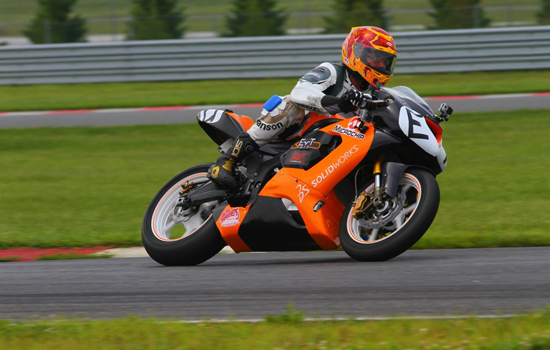Student e-motorcycle team impresses professionals
RIT electric vehicle is the only collegiate team to complete the competition and wins scholarship award
George Slack
RITEV1, the RIT Electric Vehicle One, motorcycle made a good impression on professional riders and fans at the recent eMotoRacing Varsity Challenge at the New Jersey Motorsports Park raceway. A team of engineering, industrial design and computer science students built the vehicle and raced it at the invitational event where they received a $1,000 scholarship for their efforts.
Mechanical engineering student Jeff Botticello said the RITEV1—an electric motorcycle he and his teammates built—rides with a whisper, but is 450 pounds of power and speed.
The e-vehicle team participated in the 2015 eMotoRacing Varsity Challenge at the New Jersey Motorsports Park on July 10-12. RIT was one of 10 university teams invited to the national event and the only one to complete the competition races. For their first outing and impressive showing, the team was awarded a $1,000 scholarship from one of the event sponsors, Woodcraft Technologies.
“This was the greatest experience,” said Botticello, the team project manager. “We were the only university in a competition with other professional bike teams. It was good to see how our bike would compare to those. But on the first lap of each race, our times were about the same as everyone else’s.”
The event was part of the American Historic Racing Motorcycle Association series, and this year it included a Varsity Challenge that would feature 10 university teams, including RIT. Technical challenges held a few teams back, but the RIT e-bike completed the event, keeping up with the professional teams, said Botticello. The third-year mechanical engineering student was one of 25 RIT members at the event. Over the past academic year, the group designed and built the race bike, including its custom battery management system that monitored and controlled the voltage of the 12 individual, interconnected cells at a time. Keeping the voltage uniform throughout the pack was necessary to ensure the safe operation of the lithium battery cells.
Although the students built the motorcycle, they sought a professional driver for the actual event—and their selection had an RIT connection.
“No one told us we couldn’t ride it, but we decided that motorcycle racing was a little too dangerous to put a student on the bike, so we wanted a professional rider,” said Botticello, who reached out to the race coordinator for recommendations and secured Karl Smolenski, an engineer at Cornell University’s Laboratory for Accelerator-based Sciences and Education and a professional motorcycle racer. He completed the 8-lap race on RIT’s student-built electric race-bike, keeping up with the field of competitors from national and international race teams.
“In my racing career I’ve ridden all different types of race bikes, sort of the guy who will ride anything,” said Smolenski, whose brothers, Sam and Thomas, are RIT alumni, and his father, John, attended the university as a graduate student in the 1960s. The family connection, the team’s enthusiasm and the e-bike impressed him. Tests confirmed the bike could go a full 20 miles on a single charge, the minimum needed to finish a race.
“At the race track I was stunned, since before I’d never met more than five or six members of the team at once, and in the pits there had to be 15 to 20 tents and black-shirted students everywhere. It was a real treat having a team working 24-hours-a-day on the bike,” he added. “Once the race started, we could see that we could keep up with the commercial bikes. The bike was consistently the best-handling bike out there.”
Smolenski noted the positive outcome was due to the design philosophy that the team took of using a high performance street bike and not modifying it. Commercial electric bikes are designed more for commuting, and these latter vehicles don’t often handle as well as the sport bike the RIT team designed.
“I can’t wait for next year and the next round of improvements—regenerative braking, a little more power in the batteries, and this bike will be able to challenge for the lead,” he said. “I was so proud of the team and the way their carried themselves, very professional and clearly the equal of many more experienced teams.”
According to the event announcer, RIT was going wheel-to-wheel with the professionals at 118 mph, said George Slack, lecturer in RIT’s electrical engineering department and faculty adviser to the team, who added that not only was RIT one of the fastest bikes, but it was the best looking.
“We had several industrial design students as part of our design group that made everything look good. We were very thankful for that, otherwise we were just a bunch of engineers throwing a bunch of metal together,” Botticello said, laughing.














